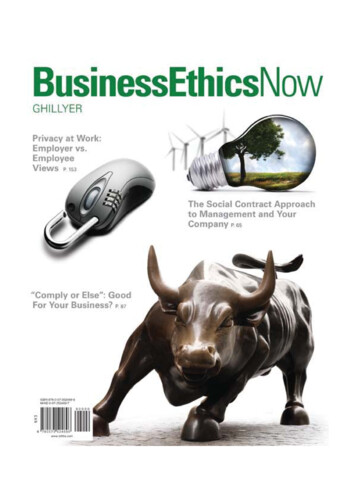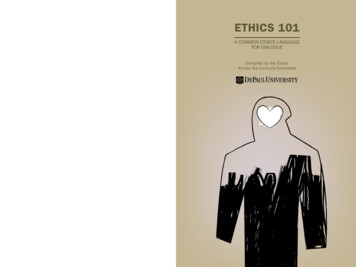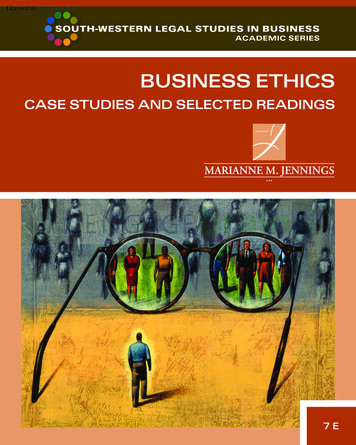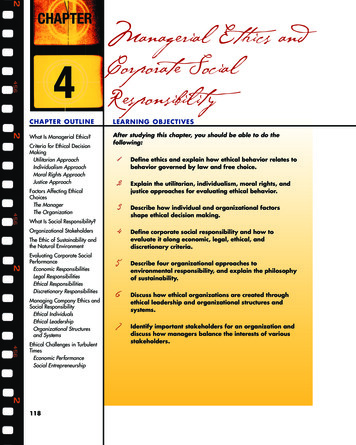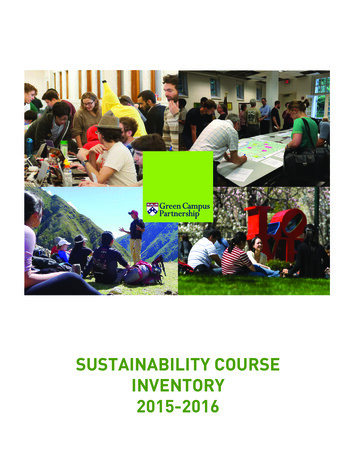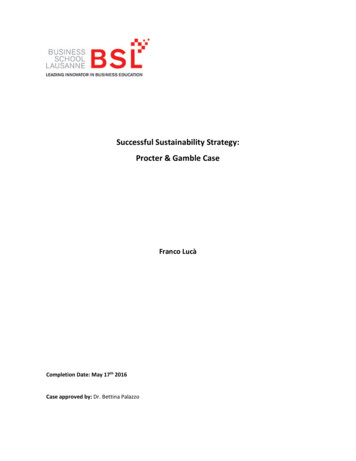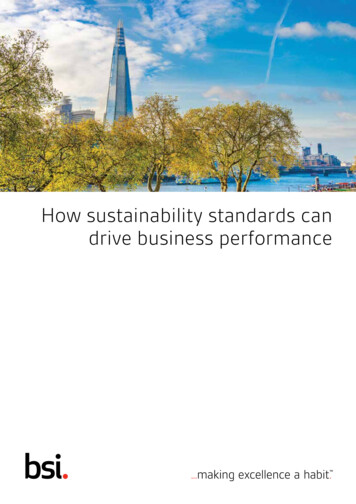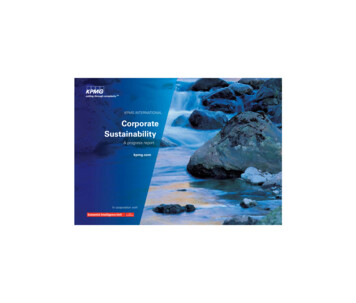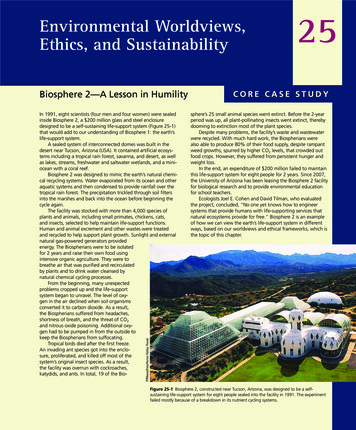
Transcription
Environmental Worldviews,Ethics, and SustainabilityBiosphere 2—A Lesson in HumilityCore Case Studysphere’s 25 small animal species went extinct. Before the 2-yearperiod was up, all plant-pollinating insects went extinct, therebydooming to extinction most of the plant species.Despite many problems, the facility’s waste and wastewaterwere recycled. With much hard work, the Biospherians werealso able to produce 80% of their food supply, despite rampantweed growths, spurred by higher CO2 levels, that crowded outfood crops. However, they suffered from persistent hunger andweight loss.In the end, an expenditure of 200 million failed to maintainthis life-support system for eight people for 2 years. Since 2007,the University of Arizona has been leasing the Biosphere 2 facilityfor biological research and to provide environmental educationfor school teachers.Ecologists Joel E. Cohen and David Tilman, who evaluatedthe project, concluded, “No one yet knows how to engineersystems that provide humans with life-supporting services thatnatural ecosystems provide for free.” Biosphere 2 is an exampleof how we can view the earth’s life-support system in differentways, based on our worldviews and ethical frameworks, which isthe topic of this chapter.PRNewsFoto/Huron Valley TravelIn 1991, eight scientists (four men and four women) were sealedinside Biosphere 2, a 200 million glass and steel enclosuredesigned to be a self-sustaining life-support system (Figure 25-1)that would add to our understanding of Biosphere 1: the earth’slife-support system.A sealed system of interconnected domes was built in thedesert near Tucson, Arizona (USA). It contained artificial ecosystems including a tropical rain forest, savanna, and desert, as wellas lakes, streams, freshwater and saltwater wetlands, and a miniocean with a coral reef.Biosphere 2 was designed to mimic the earth’s natural chemical recycling systems. Water evaporated from its ocean and otheraquatic systems and then condensed to provide rainfall over thetropical rain forest. The precipitation trickled through soil filtersinto the marshes and back into the ocean before beginning thecycle again.The facility was stocked with more than 4,000 species ofplants and animals, including small primates, chickens, cats,and insects, selected to help maintain life-support functions.Human and animal excrement and other wastes were treatedand recycled to help support plant growth. Sunlight and externalnatural gas-powered generators providedenergy. The Biospherians were to be isolatedfor 2 years and raise their own food usingintensive organic agriculture. They were tobreathe air that was purified and recirculatedby plants and to drink water cleansed bynatural chemical cycling processes.From the beginning, many unexpectedproblems cropped up and the life-supportsystem began to unravel. The level of oxygen in the air declined when soil organismsconverted it to carbon dioxide. As a result,the Biospherians suffered from headaches,shortness of breath, and the threat of CO2and nitrous oxide poisoning. Additional oxygen had to be pumped in from the outside tokeep the Biospherians from suffocating.Tropical birds died after the first freeze.An invading ant species got into the enclosure, proliferated, and killed off most of thesystem’s original insect species. As a result,the facility was overrun with cockroaches,katydids, and ants. In total, 19 of the Bio-25Figure 25-1 Biosphere 2, constructed near Tucson, Arizona, was designed to be a selfsustaining life-support system for eight people sealed into the facility in 1991. The experimentfailed mostly because of a breakdown in its nutrient cycling systems.
Key Questions and ConceptsWhat are some major environmentalworldviews?25-125-3How can we live more sustainably?We can live more sustainably by becomingenvironmentally literate, learning from nature, living more simplyand lightly on the earth, and becoming active environmentalcitizens.Concept 25-3Major environmental worldviews differ onwhich is more important—human needs and wants, or the overallhealth of ecosystems and the biosphere.Concept 25-1What is the role of education in living moresustainably?25-2The first step to living more sustainably is tobecome environmentally literate, primarily by learning from nature.Concept 25-2Note: Supplements 3 (p. S6) and 9 (p. S57) can be used with this chapter.The main ingredients of an environmental ethic are caring about the planet and all ofits inhabitants, allowing unselfishness to control the immediate self-interest that harms others,and living each day so as to leave the lightest possible footprints on the planet.Robert Cahn25-1 What Are Some MajorEnvironmental Worldviews? Major environmental worldviews differ on which is moreimportant—human needs and wants, or the overall health of ecosystems and thebiosphere.C o ncept 25-1There Are a Variety ofEnvironmental WorldviewsPeople disagree on how serious different environmental problems are and what we should do about them.These conflicts arise mostly out of differing environmental worldviews—how people think the worldworks and what they believe their role in the worldshould be. Part of an environmental worldview is determined by a person’s environmental ethics—whatone believes about what is right and what is wrong inour behavior toward the environment. Explore More:See a Case Study at www.cengage.com/login to learnmore about the environmental aspects of various philosophies and religions.Worldviews are built from our answers to fundamental questions: Who am I? Why am I here? Whatshould I do with my life? These views provide key principles or values that give us a sense of meaning andpurpose, while helping us to sort out and evaluate thecontinual flood of information and misinformation thatbombards us. People with widely differing environmental worldviews can take the same data, be logically con-662Links:refers to the Core Case Study.sistent in their analysis of those data, and arrive at quitedifferent conclusions, because they start with differentassumptions and values. Figure 25-2 summarizes thefour major beliefs of each of three major environmentalworldviews.Some environmental worldviews are humancentered (anthropocentric), focusing primarily on theneeds and wants of people; others are life- or earthcentered (biocentric), focusing on individual species, theentire biosphere, or some level in between, as shownin Figure 25-3. As you move from the center of Figure 25-3 to the outside rings, the worldviews becomeless human-centered and more life- or earth-centered.Most People Have Human-CenteredEnvironmental WorldviewsIt is not surprising that most environmental worldviewsare human centered. One such worldview held bymany people is the planetary management worldview. Figure 25-2 (left) summarizes the major beliefs ofthis worldview.refers to the book’ssustainability theme.GOODNEWSrefers to good news about theenvironmental challenges we face.
Environmental WorldviewsPl a net a r y M a n a g e m e n tWe are apart from the rest ofnature and can manage natureto meet our increasing needsand wants.Because of our ingenuity andtechnology, we will not run outof resources.The potential for economicgrowth is essentially unlimited.Our success depends on howwell we manage the earth's lifesupport systems mostly for ourbenefit.StewardshipEnvironment al WisdomWe have an ethical responsibilityto be caring managers, orstewards, of the earth.We are a part of and totallydependent on nature, and natureexists for all species.We will probably not run out ofresources, but they should notbe wasted.Resources are limited and shouldnot be wasted.We should encourageenvironmentally beneficial formsof economic growth anddiscourage environmentallyharmful forms.Our success depends on howwell we manage the earth's lifesupport systems for our benefitand for the rest of nature.We should encourage earthsustaining forms of economicgrowth and discourage earthdegrading forms.Our success depends on learninghow nature sustains itself andintegrating such lessons fromnature into the ways we thinkand act.Figure 25-2 This is a comparison of three major environmental worldviews (Concept 25-1). Questions: Which ofthese descriptions most closely fits your worldview? Which of them most closely fits the worldviews of your parents?Biosphere- centered)Anthropocentric(human-centered)degree of control that we have over natural processes.As the world’s most important and intelligent species,we can also redesign the planet and its life-support systems to support us and our ever-growing economies.This was the basic reasoning behind the Biosphere 2project (Core Case Study).Here are three variations of the planetarymanagement environmental worldview: The no-problem school: We can solve any environmental, population, or resource problem with moreeconomic growth and development, better management, and better technology. The free-market school: The best way to manage theplanet for human benefit is through a free-marketglobal economy with minimal government interference and regulation. All public property resourcesshould be converted to private property resources,and the global marketplace, governed only byfree-market competition, should decide essentiallyeverything. The spaceship-earth school: The earth is like a spaceship: a complex machine that we can understand,dominate, change, and manage, in order to providea good life for everyone without overloading natural systems. This view developed after people sawphotographs taken from outer space showing theearth as a finite planet, or an island in space (seeFigure 1-18, p. ironmentalwisdomFigure 25-3 Environmental worldviews lie on a scale running frommore self- and human-centered (center) to life-, biosphere- or earthcentered (outer rings). Also, as we move out from the center, fromhuman-centered to more earth-centered worldviews, we tend tovalue other life forms more for their right to exist than for theproducts and services they can provide for us.According to this view, humans are the planet’smost important and dominant species, and we can andshould manage the earth mostly for our own benefit.The values of other species and parts of nature are basedprimarily on how useful they are to us. According tothis view of nature, human well-being depends on theAnother human-centered environmental worldviewis the stewardship worldview. It assumes that wehave an ethical responsibility to be caring and responConcept 25-1663
sible managers, or stewards, of the earth. Figure 25-2(center) summarizes the major beliefs of this worldview.According to the stewardship view, as we use theearth’s natural capital, we are borrowing from theearth and from future generations. We have an ethical responsibility to pay this debt by leaving the earthin at least as good a condition as what we now enjoy.Stewardship is what parents do to help provide a better future for their children and grandchildren. Whenthinking about our responsibility toward future generations, some analysts suggest we consider the wisdomexpressed in a law of the 18th-century Iroquois SixNations Confederacy of Native Americans: In our everydeliberation, we must consider the impact of our decisions onthe next seven generations.Some people believe any human-centered worldviewwill eventually fail because it wrongly assumes wenow have or can gain enough knowledge to becomeeffective managers or stewards of the earth. As biologist and environmental philospher René Dubos(1901–1982) observed, “The belief that we can manage the earth and improve on nature is probably theultimate expression of human conceit, but it has deeproots in the past and is almost universal.” Accordingto environmental leader Gus Speth, “This view of theworld—that nature belongs to us rather than we tonature—is powerful and pervasive—and it has led tomuch mischief.”According to some critics of human-centered worldviews, the unregulated global free-market approach willnot work because it is based on increased degradationand depletion of the earth’s natural capital. Also, criticssay, it focuses on short-term economic benefits withlittle regard for the long-term harmful environmental,health, and social consequences that are a result of thisworldview.The image of the earth as an island or spaceshiphas played an important role in raising global environmental awareness. But critics argue that thinking of theearth as a spaceship that we can manage is an oversimplified, arrogant, and misleading way to view an incredibly complex and ever-changing planet.Critics of human-centered worldviews point outthat we do not even know how many plant and animalspecies live on the earth, much less what their roles areand how they interact with one another and their nonliving environment. We still have much to learn aboutwhat goes on in a handful of soil, a patch of forest (Figure 25-4), the bottom of the ocean, and most otherparts of the planet. As biologist David Ehrenfeld puts it,“In no important instance have we been able to demonstrate comprehensive successful management of theworld, nor do we understand it well enough to manageit even in theory.” This belief is supported by the failureof the Biosphere 2 project (Core Case Study).664Chapter 25Jim Lopes/ShutterstockCan We Manage the Earth?Figure 25-4 We have very limited understanding of how thesegiant sequoia trees in Sequoia National Park (USA), the soil underneath them, and the plants and animals in the surrounding forestecosystem survive, interact, and change in response to differentenvironmental conditions. Despite this ecological ignorance, wecontinue to clear-cut large areas of forestland throughout the world.Questions: How does this lack of knowledge relate to the planetarymanagement worldview? Does this mean that we should never cleara forest? Explain.Some People HaveLife-Centered and Earth-CenteredEnvironmental WorldviewsCritics of human-centered environmental worldviewsargue that they should be expanded to recognize thatall forms of life have value as participating members ofthe biosphere, regardless of their potential or actual useto humans. Many of the world’s religions call for suchbasic respect for all life forms. Explore More: See aCase Study at www.cengage.com/login to learn moreabout the environmental aspects of various philosophiesand religions.However, people disagree about how far we shouldextend our ethical concerns for various forms of life(Figure 25-5). Most people with a life-centered worldview believe we have an ethical responsibility to avoidcausing the premature extinction of species throughEnvironmental Worldviews, Ethics, and Sustainability
interdependent. They understand that the earth’s natural capital (see Figure 1-4, p. 9) keeps us and otherspecies alive and supports our economies. They alsounderstand that preventing the depletion and degradation of this natural capital as a key way to promoteenvironmental sustainability (Figure 25-6). They arguethat preserving the earth’s natural capital requires thatwe mimic nature by applying the three principles of sustainabiliy (see back cover) to humaneconomies and lifestyles.Earth-centered worldviews hold that becausehumans and all forms of life are interconnected partsof the earth’s life-support system, it is in our own selfinterest not to act in ways that impair the overall system.From this viewpoint, an earth-centered worldview isalso more practical than human-centered worldviews.One earth-centered worldview is called the environmental wisdom worldview. Figure 25-2 (right)summarizes its major beliefs. According to this view, weare within and part of—not apart from—the community of life and the ecological processes that sustain alllife. This view holds that the sustainability of our species, civilizations, and economies depends on the sustainability of the biosphere, of which we are just onepart. Thus, promoting global sustainabilty helps each ofus to safeguard our own individual health and safety, aswell as our future as a species. In other words, all effortsto promote sustainability are local and personal. Inmany respects, the environmental wisdom worldview isthe opposite of the planetary management worldview(Figure 25-2, left).The environmental wisdom worldview suggests thatthe earth does not need us to manage it in order for itBiosphereBiodiversity(Earth's genes, species, and ecosystems)EcosystemsAll species on earthAll animal speciesAll individualsof an animal speciesAll peopleNationCommunityand friendsFamilySelfour activities, for two reasons. First, each species is aunique storehouse of genetic information that shouldbe respected and protected simply because it exists. Second, each species has potential economic benefit forhuman use.Some people think we should go beyond focusing mostly on species. They believe we have an ethicalresponsibility to take a wider view and work to preventdegradation of the earth’s ecosystems, biodiversity, andthe biosphere. This earth-centered environmental worldview is devoted to helping to sustain the earth’s bio diversity and the functioning of its life-support systemsfor all forms of life, now and in the future.People with earth-centered worldviews believethat humans are not in charge of the world and thathuman economies and other systems are subsystemsof the earth’s life-support systems (see Figure 23-5,p. 617). Their view is that the natural system that weare all part of is holistic, that is, interconnected andCourtesy of Earth Flag Co.Figure 25-5 Levels of ethical concern: People disagree abouthow far we should extend our ethical concerns on this scale.Question: How far up this scale would you extend your ownethical concerns?Figure 25-6 The earth flag is a symbol of commitment to promoting environmentalsustainability by working with the earth at the individual, local, national, and international levels. Chief Seattle (1786–1866), leader of the Suquamish and Duwamish NativeAmerican tribes in what is now the U.S. state of Washington, summarized this ethicalbelief: “The earth does not belong to us. We belong to the earth.” Question: Do youagree or disagree with Chief Seattle’s view? Explain.Concept 25-1665
to survive, whereas we need the earth for our survival.From this perspective, talk about saving the earth makes nosense, because the earth does not need saving. Life on earthhas sustained itself for billions of years and will continuewith or without the very recent arrival of the speciesthat named itself “the doubly-wise species” (Homo sapiens sapiens). What we do need to save is the existence ofour own species and cultures—which have been aroundfor less than an eyeblink of the 3.5-billion-year historyof life on the earth—as well as the existence of otherspecies that may become extinct because of our activities. (See the Guest Essay on this topic by sustainabilityexpert Lester W. Milbrath at CengageNOW.) ExploreMore: See a Case Study at www.cengage.com/loginon the deep ecology worldview, which is related to theenvironmental wisdom worldview.Thinking AboutEnvironmental Worldviews and Biosphere 2What environmental worldview is the most compatible with the failure of Biosphere 2 (Core Case Study)?How Would You Vote? Which one of the following comes closest to your environmental worldview: planetary management, stewardship,or environmental wisdom? Cast your vote online atwww.cengage.com/login.25-2 What Is the Role of Educationin Living More Sustainably? The first step to living more sustainably is to becomeenvironmentally literate, primarily by learning from nature.C o ncept 25-2How We Can Become MoreEnvironmentally Literate?There is widespread evidence and agreement that weare a species in the process of degrading our own lifesupport system at an increasing rate and that duringthis century, this behavior will very likely threatenhuman civiilization and the existence of up to half ofthe world’s species. Part of the problem stems from ourignorance about how the earth works, what we aredoing to its life-sustaining systems, and how we canchange our behavior toward the earth. Correcting thisbegins by understanding three important ideas that formthe foundation of environmental literacy:1. Natural capital matters because it supports the earth’slife and our economies.2. Our ecological footprints are immense and are expandingrapidly; in fact, they already exceed the earth’s estimated ecological capacity (see Figure 1-13, p. 16).3. Ecological and climate-change tipping points (see Figure 19-15, p. 511) are irreversible and should never becrossed. Once we cross such a point, neither moneynor technology can save us from the resulting consequences, which could last for thousands of years.According to the environmental wisdom worldview,learning how to work with the earth, instead of thinking of ourselves as being in charge of it and thus working against it, is the key to environmental sustainabilityand thus to the sustainability of the human species. Itinvolves being motivated by hope and valuing cooper-666Chapter 25ation and moderation, instead of being driven by fearand manipulated by misinformation and believing thathaving more and more stuff is the key to happiness.Acquiring environmental literacy involves beingable to answer certain key questions and having a basicunderstanding of certain key topics, as summarized inFigure 25-7.Science writer Janine M. Benyus and various scientists have been pioneering a new science called biomimicry. They urge scientists, engineers, business executives,and entrepreneurs to study the earth’s living systemsto find out what works and what lasts and how wemight copy such earth wisdom. For example, gecko lizards have pads on their feet that allow them to cling torocks, glass, and other surfaces. Researchers are usingthis information to develop a new type of adhesivetape. Ray Anderson (see Chapter 23, Individuals Matter,p. 626) created a best-selling carpet tile that mimicksthe diverse nature of the floor of a tropical rain forest.As authors, we also studied how nature works andhow life has sustained itself, and we arrived at threeprinciples of sustainability, which we have usedthroughout this book to help you understandenvironmental problems and evaluate possiblesolutions to such problems.Can We Learn from the Earth?Formal environmental education is important, but isit enough? Many analysts say no. They call for us toappreciate not just the economic value of nature, butEnvironmental Worldviews, Ethics, and Sustainability
cal ability to act responsibly toward the earth. A growing chorus of analysts and ethicists urge us to reconnectwith and learn directly from nature as an importantway for us to help sustain the earth’s precious biodiversity and our own species and cultures.Some ethicists suggest we kindle a sense of awe,wonder, mystery, excitement, and humility by standingunder the stars, sitting in a forest (Figure 25-4), experiencing a mountain lake (Figure 25-8, top), or taking in the majesty and power of the sea (Figure 25-8,bottom). We might pick up a handful of soil and try tosense the teeming microscopic life within it that helps tokeep us alive. We might look at a tree, mountain, rock,or bee, or listen to the sound of a bird and try to sensehow each of them is connected to us and we to them,through the earth’s life-sustaining processes.Ques t i ons t o a n s w e rHow does life on earth sustain itself?How am I connected to the earth and other living things?Where do the things I consume come from and where do theygo after I use them?What is environmental wisdom?What is my environmental worldview?What is my environmental responsibility as a human being?Com p onent sBasic concepts: sustainability, natural capital, exponentialgrowth, carrying capacityThree principles of sustainablilityEnvironmental historyThe two laws of thermodynamics and the law ofconservation of matterBasic principles of ecology: food webs, nutrient cycling,biodiversity, ecological successionPopulation dynamicsSustainable agriculture and forestrySoil conservationSustainable water useNonrenewable and renewable energy resourcesClimate disruption and ozone depletionPollution prevention and waste reductionEnvironmentally sustainable economic and political systemsPichugin Dmitry/ShutterstockNonrenewable mineral resourcesEnvironmental worldviews and ethicsalso its ecological, aesthetic, and spiritual values. Tothese analysts, the problem is not just a lack of environmental literacy but also, for many people, a lack ofintimate contact with nature and little understanding ofhow nature works and sustains us.We face a dangerous paradox. At a time whenhumans have more technology and power than everbefore to degrade and disrupt nature, most people knowlittle about nature, and have little direct contact with it.Technology has led many people to see themselves asbeing apart from nature instead of being part of it all.Critics of this view warn that it distorts our understanding of what it means to be human and blunts our ethi-Epic Stock/ShutterstockFigure 25-7 Achieving environmental literacy involves being ableto answer certain questions and having an understanding of certainkey topics (Concept 25-2). Question: After taking this course, doyou feel that you can answer the questions asked here and have abasic understanding of each of the key topics listed in this figure?Figure 25-8 An important way to learn about and to appreciate nature, as well as todevelop a sense of humility, is to experience its beauty, power, and complexity firsthand. This involves understanding that we are part of—and not apart from or in chargeof—nature.Concept 25-2667
Such direct experiences with nature reveal parts ofthe complex web of life that cannot be bought, recreated through technology (Core Case Study)or in a chemistry lab, or reproduced throughgenetic engineering. Understanding and directly experiencing the precious gifts we receive at no charge fromnature can help to foster within us the ethical commitment that we need in order to live more sustainably onthis earth.ConnectionsDisconnecting from Technologyand Reconnecting with NatureMany of us who venture into the natural world want to carryour GPS units, cell phones, I-pods, and other technologicalmarvels that keep us in touch with the world we have temporarily left behind. But this stuff can divert much of our attention from the natural world that surrounds us during suchventures. If our goal is to reconnect with and experience thenatural world, it helps to disconnect from these devices.Earth-focused philosophers say that to be rooted,each of us needs to find a sense of place—a stream, amountain, a yard, a neighborhood lot—any piece of theearth with which we feel as one in a place we know,experience emotionally, and love. According to biologistStephen Jay Gould (1941–2002), “We will not fight tosave what we do not love.” When we become part ofa place, it becomes a part of us. Then we are driven todefend it from harm and to help heal its wounds.In other words, find out what you really care aboutand live a life that shows it. As Mahatma Gandhi (1869–1948), one of India’s most revered spiritual and political leaders, observed, “We must become the changewe want to see in the world.” If we think and GOODact in this way, we might discover and tap into NEWSwhat conservationist Aldo Leopold (Individuals Matter,below) called “the green fire that burns in our hearts.”We might then develop a passion for using this energyas a force for respecting and working with the earth andwith one another.I n di v i du als MatterAldo Leopold’s Environmental EthicsA All ethics so far evolved rest upon asingle premise: that the individual is amember of a community of interdependent parts. To keep every cog and wheel is the firstprecaution of intelligent tinkering.668Chapter 25Figure 25-A Individuals matter: Aldo Leopold(1887–1948) was a forester, writer, and con servationist. His book, A Sand County Almanac(published after his death), is considered anenvironmental classic that helped to inspirethe modern environmental and conservationmovements.Robert McCabe/Courtesy of the Universityof Wisconsin—Madison Archivesccording to the renowned Americanforester, ecologist, and writer AldoLeopold (Figure 25-A), the role of the humanspecies should be to protect nature, not toconquer it.In 1933, Leopold became a professor atthe University of Wisconsin and in 1935, hehelped to found the U.S. Wilderness Society. Through his writings and teachings, hebecame one of the foremost leaders of theconservation and environmental movementsduring the 20th century. His energy and foresight helped to lay the critical groundwork forthe field of environmental ethics.Leopold’s weekends of planting trees,hiking, and observing nature firsthand on hisWisconsin farm provided much of the material for A Sand County Almanac. Since then,more than 2 million copies of this environmental classic have been sold.The following quotations from his writingsreflect Leopold’s land ethic, and they form thebasis for many of the beliefs and principles ofthe modern stewardship and environmentalwisdom worldviews: That land is a community is the basicconcept of ecology, but that land is tobe loved and respected is an extensionof ethics. The land ethic changes the role of Homosapiens from conqueror of the landcommunity to plain member and citizenof it. We abuse land because we regard it as acommodity belonging to us. When we seeland as a community to which we belong,Environmental Worldviews, Ethics, and Sustainabilitywe may begin to use it with love andrespect. A thing is right when it tends to preservethe integrity, stability, and beauty of thebiotic community. It is wrong when ittends otherwise.Critical ThinkingWhich of the quotations above do you agreewith? Which, if any, of these ethical principlesdo you put into practi
25-3 How can we live more sustainably? CON C EPT 25-3 We can live more sustainably by becoming environmentally literate, learning from nature, living more simply and lightly on the earth, and becoming active environmental citizens. Note: Supplement

